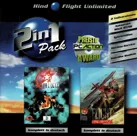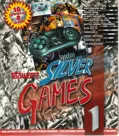Flight Unlimited
Description official description
Flight Unlimited is a civilian flight simulator. You can choose between an Extra 300s, a Bellanca Decathlon, a Sukhoi SU-31, a Pitts S-2B and a Grob S-103. Take part in aerobatic competitions or, if you're a beginner, learn how to fly in 34 lessons.
Flight Unlimited stresses reality: all ground textures and elevations are based on real satellite photodata, and the flight model has a heavy basis in real world physics. The manual is quite detailed, and combined with the in-flight tutorials, the user is provided with a very gradual introduction to flying.
A very comprehensive piece of work, and a defining title for Looking Glass, whose only competition at the time was Microsoft Flight Simulator (which looked immediately dated compared to Flight Unlimited).
Groups +
Screenshots
Promos
Videos
Add Trailer or Gameplay Video +1 point
See any errors or missing info for this game?
You can submit a correction, contribute trivia, add to a game group, add a related site or alternate title.
Credits (DOS version)
92 People (81 developers, 11 thanks) · View all
| Programming | |
| Graphics / Artwork | |
| Sound | |
| Production | |
| [ full credits ] | |
Reviews
Critics
Average score: 84% (based on 24 ratings)
Players
Average score: 3.5 out of 5 (based on 21 ratings with 2 reviews)
The Good
Compared to other flight-sims, this game calculates the movement of the plane much more realistic than any of it's contemporaries.
The terrain was breathtaking and quite unique, as it was based upon aerial photographs.
The Bad
There are occasional hick-ups in the graphics department...
The ground perspective sometimes get wrong and straight lines bend. It may look weird, but do not degrade the overall experience in my opinion.
The Bottom Line
It's a simulation of civil airplanes. But it is still major fun because the whole idea is to do aerobatics.
There are lots of lessons which teach you how to do all the stunts.
It's said that the developers struggled with one of the featured planes; the Sukhoi. Something were wrong, as it didn't properly enter a spin. The solution was provided by a real Sukhoi pilot. It was nothing wrong with the 3-D model of the plane, nor with the math calculating the planes movement. It was simply a pilot error: The powerful ailerons of the Sukhoi should not be deployed at maximum deflection, but only half way. They tried this, and the Sukhoi entered the spins like never before...
Get hold of this sim, even if it is the DOS-only version!
DOS · by Henning Haraldsen (2) · 2001
Ground-breaking and gorgeous, though not without its limitations.
The Good
When Flight Unlimited debuted in 1995, there was nothing else like it on the market. Never before had a commercially available flight sim offered such a compelling combination of beautiful fully-textured graphics and an innovative, realistic flight model. And not since Chuck Yeager’s Advanced Flight Trainer 2, released some five years earlier, had a sim focused primarily on aerobatic flying. Flight Unlimited instantly raised the bar within the flight sim genre, and its processor-hungry graphics were the excuse many gamers needed to finally upgrade to Pentium-class hardware.
As an audiovisual experience, Flight Unlimited was an absolute standout, especially in an era before 3D accelerators. It featured beautiful photorealistic terrain, fully-textured virtual cockpits, and high-fidelity audio, all of which summed up to a deeply immersive experience. A wide variety of viewing angles gave you a thorough look at your aircraft from both inside and out. Pushing the plane to its structural limits caused the airframe to groan and creak under the stress. The wind howled at high speeds and the sun threw lens flares across the screen. Even the main menu was a treat, eschewing the traditional 2D point-and-click interface for a three-dimensional FBO that could be explored much like a first-person shooter. To select your plane, you chose one of five 3D models on a table at one end of the room. To change airports, you strolled over to a globe, and to view the game credits you walked to an arcade machine. Occasionally, a dog would bark in the distance.
Once you were airborne, Flight Unlimited’s ground-breaking aerodynamics model immediately made its presence felt. The planes moved in a very convincing, nuanced manner thanks to real-time computational fluid dynamics, which simulated the airflow across each individual flying surface. Stalls, spins, and other envelope-breaking maneuvers could all be performed, and transitions between flight attitudes were smooth and natural. The gyroscopic effects of prop-torque would assert themselves as you throttled-up, while excessive g-loading and aerodynamic flutter could rip your plane apart. The atmosphere even featured thermals, pockets of rising air in which glider pilots circle to stay aloft, which provided an extra challenge when soaring the the Grob.
Flight Unlimited offered a good amount of “edu-tainment” value, as it included over 30 interactive lessons for a variety of aerobatic maneuvers, as well as basic factual information about each of the included planes. It also offered an excellent variety of configuration options to suit your hardware and skill level. A variety of resolutions (up to 640x480) and visual quality settings allowed owners of 486 systems to get in on the action, while realism options like indestructability made the sim accessible to neophytes. And it even supported virtual reality headsets, a bonus for the handful of people who actually owned one.
The Bad
Despite all the aforementioned pizzazz, "Flight Unlimited" is a bit of a misnomer, since the sim is actually quite limited in scope. Most civilian flight simulators place an emphasis on navigating through a realistic world environment, with features like dynamic user-configurable weather, comprehensive instrumentation, and geographically-accurate terrain that contains a bevy of navaids and airports. In Flight Unlimited, you’re stuck over a small, tiled patch of land with a single landing strip. There are no other planes in the sky, no buildings on the ground, and no instruments aside from the essential altimeter, variometer, airspeed indicator, load indicator, and throttle gauge. The cockpit doesn’t even feature a compass, since it really doesn’t matter which way you’re headed – there’s nowhere to go. The net effect was limited playability, and after experimenting with the various planes, locations, and aerobatic maneuvers for a few hours, there was little left to do.
Of course, Flight Unlimited’s narrow scope was a conscious design decision springing from a focus on innovation and aerobatics, and to fault the sim for it would be like dismissing a Formula-1 racecar for its lack of trunk space. If fiddling with radio frequencies during six-hour flights over farmland was your thing, Microsoft Flight Simulator was happy to oblige you. Looking Glass did eventually add the standard flight-sim staples to Flight Unlimited II and III, but they diluted the sim in the process, and neither sequel had the character or appeal of the original.
One final note: despite the computational wizardry behind Flight Unlimited’s fluid dynamics model, it was a bit rough around the edges. Ground handling was utterly horrid, which made takeoffs and landings a complete waste of time. And extreme maneuvers would occasionally produce unrealistic results like impossibly rapid spins that ripped the plane apart.
The Bottom Line
As an innovative, beautiful, and historically significant sim, Flight Unlimited definitely deserves a place on any collector’s shelf. It is by no means a substitute for more comprehensive civilian flight simulators, and it won’t offer any opportunities to down Messerschmitts over the English Channel, but it will provide several hours of unique entertainment and leave a smile on your face.
DOS · by SiliconClassics (848) · 2009
Trivia
Credits
Viewing the credits for the game brings up a neat tiltable "plate" where gelatinous cubes fall down one by one and bounce on it; each cube bears the face of one of the programmers. Like the game, this section is also based on real-world physics, as cubes bounce, wobble, bend, and deform as they hit the plate. The user can even tilt the plate to alter the strike, bounce, and roll of the cubes!
Error message
When a fatal error occurs, the following message is displayed above the register dump:
Someday you will ache like I ache.
Graphics
The graphics engine for Flight Unlimited was designed with the future in mind. Most graphics cards back then might have been able to hit 1024x768 if they were lucky, but the game was designed to output even higher than that. It even supported old VR helmets.
Technology
The DOS version of this game does not interact with it's 32-bit DOS extender very well; it makes the game unstable, and also makes it nearly impossible to capture screenshots from it.
Awards
- Computer Gaming World
- June 1996 (Issue #143) – Special Artistic Achievement Award for Physical Model
- November 1996 (15th anniversary issue) – #5 Best Way To Die In Computer Gaming (plane crashes with the physics model)
- GameStar (Germany)
- Issue 12/1999 - #97 in the "100 Most Important PC Games of the Nineties" ranking
Information also contributed by Adam Baratz
Analytics
Identifiers +
Contribute
Are you familiar with this game? Help document and preserve this entry in video game history! If your contribution is approved, you will earn points and be credited as a contributor.
Contributors to this Entry
Game added by robotriot.
Macintosh added by vga256. Windows added by Geoffrey Palmer.
Additional contributors: Trixter, Patrick Bregger.
Game added January 28, 2000. Last modified September 14, 2024.





























